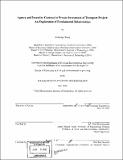| dc.contributor.advisor | Fred Moavenzadeh. | en_US |
| dc.contributor.author | Chiang, Risharng | en_US |
| dc.contributor.other | Massachusetts Institute of Technology. Dept. of Civil and Environmental Engineering. | en_US |
| dc.date.accessioned | 2005-08-23T19:37:16Z | |
| dc.date.available | 2005-08-23T19:37:16Z | |
| dc.date.copyright | 2002 | en_US |
| dc.date.issued | 2002 | en_US |
| dc.identifier.uri | http://hdl.handle.net/1721.1/8375 | |
| dc.description | Thesis (Ph.D.)--Massachusetts Institute of Technology, Dept. of Civil and Environmental Engineering, 2002. | en_US |
| dc.description | Includes bibliographical references (p. 171-177). | en_US |
| dc.description.abstract | This thesis codifies and relates critical incentive-design and financial-contracting issue to the unique principal-agent circumstances generated from private investment of transport infrastructure and provides a framework for designing incentive contract and increasing future economic efficiency gains (or minimizing loses). In the mathematical form, we uniquely integrated multitask agency and common agency into our modeling. The outcome could be simplified as: the equilibrium with n principals is exactly as if there is just one hypothetical principal with an objective function that is the sum of all the separate principals' objectives, but the agent's risk aversion is multiplied n-fold. Remember that the more risk averse the agent, the lower the power of the incentive scheme. Thus, the Nash equilibrium incentive scheme with n principals has, roughly speaking, only (/n)-th the power of the second-best scheme that would be offered by one truly unified principal. With promotion of incentive competition among the Government and the Board the incentives can be more powerful than those in the second-best. The reason is that each must now use a positive coefficient on the component of output that is of direct concern to him in order to divert the CEO from tasks that benefit the other. This competition among the Government and the Board leads them to raise those coefficients to higher levels. The most important predictions of the theoretical model are as follows. First, when transport service consumers view the output of tasks as complementary, CEOs should be given lower-powered incentives from the Board and higher-powered incentives from the Government. | en_US |
| dc.description.abstract | (cont.) For government, to encourage efforts allocated to primary transport service, less complementary second activity should be discouraged. Second, when uncertainty across tasks is highly correlated, CEOs should also be given lower powered incentives. Indeed, a positive relationship increases the CEO's risk and therefore her need for insurance. A negative relationship, in contrast, is a source of risk diversification. From incentive regulation perspective, higher-powered incentive should be given when the relationship is positive and lower when it is negative. All of these predictions are confirmed by the empirical data. | en_US |
| dc.description.statementofresponsibility | by Risharng Chiang. | en_US |
| dc.format.extent | 177 p. | en_US |
| dc.format.extent | 12917212 bytes | |
| dc.format.extent | 12916971 bytes | |
| dc.format.mimetype | application/pdf | |
| dc.format.mimetype | application/pdf | |
| dc.language.iso | eng | en_US |
| dc.publisher | Massachusetts Institute of Technology | en_US |
| dc.rights | M.I.T. theses are protected by copyright. They may be viewed from this source for any purpose, but reproduction or distribution in any format is prohibited without written permission. See provided URL for inquiries about permission. | en_US |
| dc.rights.uri | http://dspace.mit.edu/handle/1721.1/7582 | |
| dc.subject | Civil and Environmental Engineering. | en_US |
| dc.title | Agency and incentive contract in private investment of transport project : an exploration of fundamental relationships | en_US |
| dc.type | Thesis | en_US |
| dc.description.degree | Ph.D. | en_US |
| dc.contributor.department | Massachusetts Institute of Technology. Department of Civil and Environmental Engineering | |
| dc.identifier.oclc | 50556810 | en_US |
